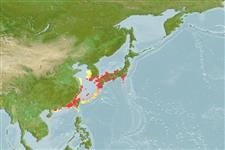Environment: milieu / climate zone / depth range / distribution range
Sinh thái học
Biển Cùng sống ở rạn san hô; Mức độ sâu 0 - 30 m (Ref. 89707). Tropical; 37°N - 20°N, 112°E - 143°E (Ref. 5222)
Northwest Pacific: southern Japan, Korea, Taiwan, and China. Reports of the species (under the valid name or as Epinephelus fario) from the Indian Ocean are apparently based on misidentifications.
Length at first maturity / Bộ gần gũi / Khối lượng (Trọng lượng) / Age
Maturity: Lm ?, range 29 - ? cm
Max length : 50.0 cm TL con đực/không giới tính; (Ref. 89707)
Các tia vây lưng cứng (tổng cộng): 11; Các vây lưng mềm (tổng cộng): 16-17; Tia cứng vây hậu môn 3; Tia mềm vây hậu môn: 8. Preopercle rounded; serrae mostly hidden by skin; upper edge of operculum straight; nostrils small, subequal; maxilla reaches to or beyond vertical at rear edge of the eye. Area behind pectoral-fin tip with a patch of ctenoid scales in juveniles. Color is pale brown with small red or reddish brown spots. Fins darker, also covered with spots and often with a narrow white edge. A black blotch is at the base of the last 3 dorsal-fin spines, a smaller blotch at the base of the middle dorsal-fin rays, and a third on top of the caudal peduncle. Distinguished further by the following characteristics: body depth contained 2.7-3.3 times in SL; head length 2.4-2.6 times in SL; slightly convex interorbital area; small anterior and posterior nostrils, subequal; maxilla reaches to or past vertical at rear edge of eye; 2 rows of teeth on midlateral part of lower jaw (Ref. 89707).
Juveniles are common in tide pools and in shallow clear water around rocks and coral reefs; adults found in deeper water. Kuo et al. (1988, Ref. 6826) induced sex reversal and artificial spawning (referred to as 'Epinephelus fario').
Life cycle and mating behavior
Chín muồi sinh dục | Sự tái sinh sản | Đẻ trứng | Các trứng | Sự sinh sản | Ấu trùng
Heemstra, P.C. and J.E. Randall, 1993. FAO Species Catalogue. Vol. 16. Groupers of the world (family Serranidae, subfamily Epinephelinae). An annotated and illustrated catalogue of the grouper, rockcod, hind, coral grouper and lyretail species known to date. Rome: FAO. FAO Fish. Synop. 125(16):382 p. (Ref. 5222)
IUCN Red List Status (Ref. 130435)
Threat to humans
Harmless
Human uses
Các nghề cá: Tính thương mại; Nuôi trồng thủy sản: thực nghiệm
Thêm thông tin
Các tài liệu tham khảoNuôi trồng thủy sảnTổng quan nuôi trồng thủy sảnCác giốngDi truyềnElectrophoresesDi sảnCác bệnhChế biếnNutrientsMass conversion
Các công cụ
Special reports
Download XML
Các nguồn internet
Estimates based on models
Preferred temperature (Ref.
123201): 18.7 - 25.4, mean 22 °C (based on 196 cells).
Phylogenetic diversity index (Ref.
82804): PD
50 = 0.5000 [Uniqueness, from 0.5 = low to 2.0 = high].
Bayesian length-weight: a=0.01175 (0.00571 - 0.02419), b=3.04 (2.88 - 3.20), in cm total length, based on LWR estimates for this Genus-body shape (Ref.
93245).
Mức dinh dưỡng (Ref.
69278): 4.0 ±0.66 se; based on food items.
Thích nghi nhanh (Ref.
120179): Trung bình, thời gian nhân đôi của chủng quần tối thiểu là 1.4 - 4.4 năm (Preliminary K or Fecundity.).
Fishing Vulnerability (Ref.
59153): Moderate vulnerability (40 of 100).
Nutrients (Ref.
124155): Calcium = 29.3 [14.3, 61.4] mg/100g; Iron = 0.479 [0.264, 0.999] mg/100g; Protein = 18.6 [17.1, 20.0] %; Omega3 = 0.117 [0.074, 0.185] g/100g; Selenium = 29.1 [17.4, 52.6] μg/100g; VitaminA = 198 [54, 707] μg/100g; Zinc = 1.29 [0.89, 1.81] mg/100g (wet weight);
